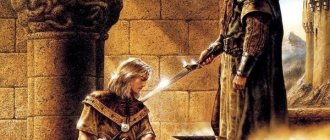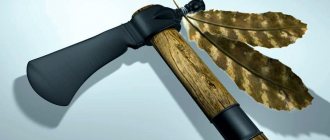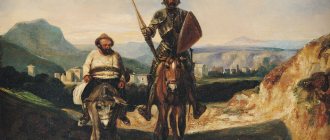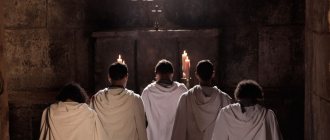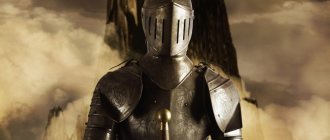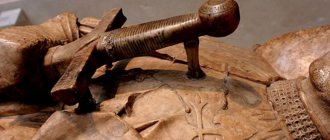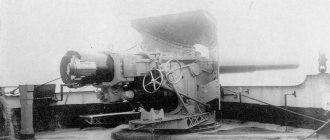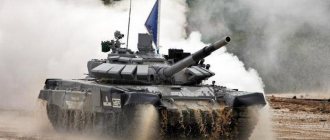Knight
- a heavily armed mounted warrior, a bearer of the noble knightly tradition, dating back to the times of the Andal invasion of Westeros and closely intertwined with the belief in the Seven. Knights occupy an important place in the feudal society and culture of Westeros, standing below the lords but above the common people. Heavy knightly cavalry is the main argument in any war of the Seven Kingdoms, and many songs and books are dedicated to the exploits and adventures of famous knights. A knight is obliged to serve as an example of honor, courage and nobility, to serve the king and the state and protect the weak - alas, not all knights correspond to this ideal image.
Knights are addressed as " ser
"(English
ser
)[1]. The title of knight is not hereditary and does not mean hereditary nobility in itself; the legitimate children of a knight inherit his surname, and if the son of a knight himself becomes a knight, also the coat of arms[2]. Any knight can knight any person, even a commoner, but the title of knight requires considerable expenses - a knight must own expensive weapons, armor, several horses, and lead a lifestyle corresponding to the knighthood, usually associated with military service and, in peacetime, tournaments[ 2].
In medieval culture, knighthood was not just a badge of honor, as in our world when Queen Elizabeth knighted Elton John. This is an occupation, a military profession. To be a knight you need wealth - at least to buy yourself armor and a horse, and a knight has responsibilities. The knight must participate in battles, appear when called by the lord, train and arm a detachment of men-at-arms. Some people are physically unable to do all this (Willas Tyrell, Samwell Tarly), and they prefer a career as a septon, maester, or simply a lord in their estate. Others are simply not interested in the life of a knight. Chivalry is also associated with religion, and for this reason, followers of the Old Gods do not become knights, even if they qualify for knighthood in all other respects. So said Martin
History and spread of chivalry
A knight in plate armor and a bascinet helmet.
Illustration by Ruisma The knightly tradition began during the conquest of Westeros by the Andals. According to the annals of the Vale of Arryn, the first region of Westeros to be conquered by the Andals, the Andals already had heavy armored cavalry, and Andal heroes - for example, Artis Arryn - bear the title "ser" in legends. Arthys Arryn's silver armor and winged helmet made him easily recognizable among the Andal warriors.[3]
On the contrary, the chronicles of the Reach claim that chivalry originated there, on the green fields of this region; Prostorian legends even call the name of the first knight - John Tall Oak, the son of Garth the Greenhand and the giantess and the founder of the house of Oakheart[4]. This is probably a myth, because if John Tall Oak existed, he lived in the Age of Heroes, long before the appearance of the Andals. However, it is known that the historical books of Westeros are full of anachronisms and inconsistencies, including knights who allegedly performed feats a thousand years before chivalry even appeared[5]; in the same way, Servin the Mirror Shield, Simeon the Star-Eyed, Florian or Galladon of Morne, who supposedly lived in time immemorial, are called knights in songs and fairy tales. Gwaine V Gardener was the first king of the Reach to be knighted under the influence of the Andals in his service.
By the time of the saga, the Reach is the center of the knightly tradition in the Seven Kingdoms. Here, chivalry is valued most highly, the requirements for knights are the most stringent, and the rules of tournaments are the most rigid and unchangeable[6].
At the same time, in the North and the Iron Islands, inhabited by the descendants of the First Men, the knightly tradition has not taken root, and knights are rare there. This is due not least to religious considerations: knightly culture, knightly vows, the rite of initiation into knights are closely related to the belief in the Seven, and the outskirts of the state where other religions are widespread - belief in the Old Gods in the North and belief in the Drowned God on the Iron islands - the knightly tradition was not accepted[7]. In the North, however, there are horsemen similar to knights.
On the contrary, in Dorne, whose population consisted of descendants of the Rhoynar mixed with the Andals, knightly traditions were successfully instilled and produced many outstanding examples of chivalry, such as Arthur Dayne and Lieven Martell. It is believed that the Dornish are the best tournament fighters in the entire state[8].
Outside of Westeros, chivalry is associated with people from the Seven Kingdoms who have preserved knightly traditions and faith in the Seven. On the lands of the Free Cities, knights - emigrants and descendants of emigrants who fled overseas for various reasons - are mainly engaged in mercenary work, fighting first for one Free City, then for another: for example, Jorah Mormont fought in the war with the Braavosi, and then entered the service to Viserys Targaryen, and Osmund Kettleblack served in the detachment of the Glorious Cavaliers, fighting either for the Foxes or for Tyrosh[9]. Five hundred knights served in the mercenary detachment of the Golden Swords[10].
Establishment of Christianity
Christianity , the spiritual basis of European medieval civilization, originated in the 1st century. n. e. in the region of Palestine , which became the Roman province of Judea . There they began to worship the Son of God Jesus Christ . From the year of the birth of Christ, according to the chronology of the Christian world, our era (AD) begins.
Under the influence of Christianity, the moral ideal of the knight was developed. The Christian faith obliged the knight to adhere to the oath given to his lord, to help the weak, and to fight injustice. She united the knighthood of different states into an international military brotherhood and led it into the crusades.
About Christ and faith
Christianity is based on the teachings of Jesus Christ. According to Christian faith, Jesus Christ was the Son of God , miraculously born of an earthly woman, the Virgin Mary . He was the Savior of mankind (Messiah), whose coming was predicted by ancient prophecies. The life and teachings of Christ are set out in four sacred books - the Gospels . According to the Gospels, Jesus was born in 1 AD. e. in the Jewish city of Bethlehem . At the age of 30, he was baptized by the prophet John (later called John the Baptist ), who recognized him as the Savior, and began to preach his teaching. Jesus taught that by observing special moral laws - commandments and continuously improving oneself spiritually, one can achieve salvation from the eternal torment awaiting sinners and be cleansed from the original sin committed by the ancestors of mankind Adam and Eve (they ate the forbidden fruit and were expelled by God from paradise ).
Christ's teachings went against the ancient religion of the Jews , and were considered dangerous. In 33, Christ's disciple Judas betrayed his teacher, and Jesus was captured on charges of violating the religious law of the Jews. The Jewish priests sentenced him to death, and the Roman governor Pontius Pilate confirmed their sentence. Jesus was executed by being crucified on Mount Golgotha in the capital of Judea, Jerusalem . Jesus' body was placed in a tomb, but on the third day the tomb was found empty. Soon the resurrected Jesus appeared to his disciples in the flesh, confirming them on the path of a new faith, and on the fortieth day he ascended to heaven. Disciples and followers of Christ - the apostles , endowed by him with special power, dispersed throughout the world, preaching Christianity.
About the difficult path of Christianity
The pagan Romans , usually tolerant, saw Christianity as a threat to the Empire. Christians, unlike adherents of other religions of the multinational Empire, did not accept the Roman gods and did not believe in the divinity of the pagan imperial power. In the Roman Empire, Christians were persecuted. But Christianity gradually gained supporters in the form of noble Romans. Christian communities - churches - began to be given money, land, and slaves. By the end of the 2nd century. Christians became an influential social force, although their persecution by the authorities continued.
About the church, the support of power
The Roman Emperor Constantine the Great , appreciating the strength of the Christian church organization, decided to turn it to his advantage. In 313, he recognized the equality of Christianity with other religions and received the support of the Church , and at the end of his life he himself converted to Christianity. Under Emperor Theodosius the Great in 380, Christianity became the state religion and replaced paganism. Theodosius made the Sophia Cathedral in Constantinople (now Istanbul ) the main Christian temple. the barbarian kings adopted Christianity .
Emperor Justinian offers the Cathedral of St. Sophia to the Mother of God, and Emperor Constantine offers the city of Constantinople. Mosaic of St. Sophia Cathedral in Constantinople (Istanbul). X century
Christian cross. Rome. VI century
About the Orthodox and the Arians
Early Christian communities interpreted the fundamentals of Christ's teachings differently, which prevented Christianity from developing into a single religion with firm, non-criticizable provisions. A split has emerged. Supporters of orthodox teaching considered Christ to be God the Son, equal to God the Father. The followers of the Alexandrian priest Arius , the Arians, argued that Jesus was created by God, which means he is not equal to God the Father, he is not God, but only the messenger of God on earth.
The Holy Trinity. Mosaic from the Temple of San Vitale. Ravenna. XI century
Church of St. Irene in Constantinople (Istanbul). According to one legend, Emperor Constantine was baptized here. Cross – mosaic from the 8th century.
The Roman Emperor Constantine , who saw in Christianity an idea capable of uniting the empire, decided to overcome the schism, and in 325 he convened the Council of Nicaea Nicaea . At this meeting, supporters of orthodox teaching ( orthodoxies the creed was adopted - the main church provisions that affirmed the unity and equality of the Holy Trinity - God the Father, God the Son and the Holy Spirit. Arius was sent into exile, his teaching was condemned. Rome became the center of Orthodoxy . But the barbarian kings , trying to dissociate themselves from imperial ideas, did not accept orthodox teachings until the 6th century. professed Arianism . There were also many Arians in Byzantium , which demonstrated its isolation from the Western Roman Empire .
Qualities of a Knight
Knight.
Illustration by Jason Engle The vows, books, songs, and legends about famous knights given during knighting created an ideal image of a noble warrior in the minds of Westerosi. In fact, very few who bear the knighthood correspond to the bright image of the “true knight”. The manifestation of high knightly qualities evokes admiration and respect among others, while “false” knights, who have stained themselves with unknightly actions, enjoy disrepute.
The knight must:
- to be a strong and skilled warrior, to fight well with swords, spears and axes, to be a skilled horseman;
- show valor in battle, maintain a fighting spirit and not show cowardice[11][2], when defeated - do not scream in pain and do not beg for mercy[12];
- be fair and take the side of right against wrong[2];
- protect the weak, especially children and women who cannot defend themselves[2], do not offend them;
- honor the gods, defend the faith in the Seven, its servants and temples[2][13]; however, many knights regard excessive piety as a sign of weakness[14];
- in war, obey the orders of commanders and superiors, taking an oath to someone - to show loyalty, protect the master at all costs[15], carry out his orders and tell him only the truth[14];
- fight for the state and defend it from enemies[2];
- be courteous and courteous, especially towards women[16][14];
- show generosity and magnanimity; returning his armor and horse to a defeated enemy without ransom[17] or sending your own doctor to the wounded is an extremely worthy act[2];
In the songs, the knights never killed magical animals, such as, for example, white deer - they only came up and stroked them[16].
It is worthy for a knight to achieve glory and honor, even at the risk of his life. To die fighting for your king is a glorious death for a knight[2].
A knight must protect his honor. It is unworthy to offend the weak and innocent; the belief that "true knights would not harm women and children" was not uncommon in Westeros.[18][19] It is believed that no real knight will consent to the murder of women[20]. There are stories about knights and ladies who slept in the same bed, putting a sword between them - the knight thus demonstrated that he was not encroaching on the lady’s honor[21]. A knight must not kiss a lady without her permission[22].
The oath of one's knightly honor is sacred[23], the word of a knight is worth a lot[24]. A good knight is honest in everything and always tells only the truth, even to his enemies[25]. A knight who has stained himself with robbery and violence may be deprived of his knighthood and put to death as a common criminal[26][17]
If a foot opponent comes up against a mounted knight for a one-on-one duel, it is worthy to dismount [27]. It is shameful to win a duel dishonestly, for example, by killing a horse under an opponent[2][16]; deliberately losing to a higher-born and richer opponent is not considered a worthy act, although it does not bring shame to the loser[2][17]. It is dishonorable to lose weapons and armor in a tournament and not give them to the winner, even if this threatens the loser with the loss of his knighthood[2][17]. Using the services of spies and informers dishonors a knight[28].
Sandor Clegane, who regarded all these stereotypes with morbid contempt and refused to accept knighthood, said:
What do you think they are for, knights? Receive insignia from ladies and show off in golden armor? The business of knights is to kill. Sandor Clegane // A Clash of Kings, Sansa IV
- A knight is a sword on horseback. Everything else - vows, anointing and worship of beautiful ladies - are just ribbons that are tied to this sword. Maybe these ribbons make the sword more beautiful, but they don’t stop it from killing. Sandor Clegane // A Storm of Swords, Arya VI
Weapons and armor
The rank of knight requires more expensive weapons than ordinary soldiers. Although in general descriptions of weapons and armor in Westeros are focused on the Hundred Years' War - the battles of Agincourt, Crecy and Poitiers, Martin easily and consciously mixes elements from different centuries. For example, the word "halfhelm" (halfhelm), according to Martin, means the classic Norman helmet with an open face and nosepiece - such as were in use during the Norman conquest of England in the 11th century; conversely, full plate armor came into use only centuries later[29]. Many knights use large tophelm helmets, both with a visor and deaf; Some characters, even in war, use unusual helmets that make their owners easily recognizable - such as Robert Baratheon’s helmet topped with stag antlers, Jaime Lannister’s lion helmet, or Sandor Clegane’s famous helmet in the shape of a dog’s head.
Martin sees some grounds for such a mixture in medieval practice - after each major battle of the Hundred Years' War, changes occurred in the armament of the parties, but at the same time the old armor remained in use. In general, the armor used in the south of Westeros is from a later era than in the north: while the knights of the Reach wear full plate armor, the warriors of the North usually make do with chain mail, and the wildlings beyond the Wall wear even more primitive armor.[29] Knights in Westeros actively use shields with a coat of arms, although in real history the combination of plate armor and a shield in the left hand was rarely used. Martin, in his own words, made this choice rather for aesthetic reasons: “shields are cool”[29].
Since knights usually fight on horseback, spurs serve as a sign of a knight: knighthood is said to be “received spurs.”[30] Wealthy knights and lords may wear golden spurs[2].
Knight tournaments are exclusively equestrian duels.
Still from the series “Game of Thrones”
What does a normal tournament look like according to a person who, for example, watched “Game of Thrones”? Two knights in armor climb onto their horses. The squires give them shields and pikes. The knights, at the signal from the trumpet, accelerate and crash into each other. Whoever stays in the saddle after this is the winner.
In principle, equestrian competitions in the Middle Ages were held approximately this way, but tournaments were not limited to this.
In addition to horse fights with pikes, there were also fights on foot Tournament, joust a l'outrance. And sometimes even with different weapons: one knight with a sword, another with an ax or spear, and so on. Battles of the “squad against detachment” type also occurred, both on horseback and on foot. And in this case, the winner was the last team member standing on his feet.
Pages and squires
Squire.
Illustration by Pat Loboyko for RPG by Green Ronin The preparation of a future knight begins at an early age. From the age of eight years and older, boys are sent to be raised in another family - the house of a lord or a noble knight, preferably a famous warrior. This practice is combined with the tradition of taking pupils and hostages from other houses. Young children often serve adults as pages
(English
page
) and
cupbearer
(English
cup-bearer
), and this occupation is considered honorable and worthy even for people from noble houses. For example, Addam Marbrand served as a page at Casterly Rock as a child, and Merrett Frey served at Crakehall Castle. Already at this age, children begin to be taught military skills - to fight with wooden swords wrapped in cloth[31], to ride a horse, and to practice with stuffed animals, quintanas and rings.
When a boy is old enough to be taken to war - by the age of twelve and sometimes even ten - he becomes a squire
(English
squire
) this or that knight. Squires are obliged to take care of the knight’s weapons, armor and horses during the campaign, prepare food, monitor the knight’s health, dress him in armor before battle, and the like. Under the command of a knight, the squire must gain an understanding of the principles of chivalry, the foundations of knightly honor, duty and loyalty; learn fencing, horse riding and courtly etiquette. In reality, it all depends on which knight the squire serves. Thus, Podrick Payne was taught by his first knight masters to brush a horse, pick stones from horseshoes and steal food, but they did not teach him how to wield a sword at all[32]. On the contrary, Arlan Pennytree, even as a poor hedge knight, taught his squire Dunk to hold a sword and spear, ride a war horse, trained him in heraldry and instilled maxims like “A true knight must be pure in body and soul”[2] and “Always do more than what is expected of you, and never less.”[14]
A proven squire can be knighted upon reaching adulthood[33], although some particularly distinguished squires are awarded this honor earlier - Jaime Lannister, for example, became a knight in his fifteenth year[9].
Having a squire is a matter of prestige for knights, and poor knights like Arlan Pennytree may take homeless boys as squires, promising to feed, teach and, in the indefinite future, knight [2]. On the contrary, rich and influential knights and lords may have several squires from noble houses at once - for example, Sumner Crakehall had no less than four squires, including Jaime Lannister and Merrett Frey, and Jaime Lannister himself later took three noble teenagers as squires at once — Lewis Piper, Garrett Pag and Josmin Peckledon[34]. The friendship between a knight and his squire and the squires of one knight is forged for life; sometimes - as in the case of Renly Baratheon and Loras Tyrell - she resorts to homosexual relations[8].
The squire does not have to be a teenager. Manderly had squires under the age of forty[35], and the squires' meal in Whitewall's courtyard was dominated by old, seasoned warriors[17]. Such people never become knights - often they simply do not have enough money for their own weapons, armor and horse, sometimes they simply do not feel the desire to become knights, preferring to serve others faithfully[36].
...like an army sergeant who has no desire to become a lieutenant, much less a general. That's what Martin said
Black gothic armor
Another question arises: did the Black Army soldiers paint their armor, which is why they allegedly got their name?
A number of visual sources actually showed warriors in black Gothic armor, but there were images where the armor had the usual grayish-steel tint. Probably, both options were encountered, and perhaps black armor was allowed to be worn by experienced warriors who had gone through a number of campaigns and deserved to have a distinctive feature to correspond to the name of the army.
Knighting
Anointed Knight.
Illustration by Pat Loboyko for RPG by Green Ronin Any knight can knight any other person[37][2]. The king can knight any of his subjects; Not every lord can knight someone, but only a lord who is a knight himself. In other words, Baelor the Blessed, being a king, could knight people, but Eddard Stark, being a lord, but not being a knight, could not[38].
The usual way to become a knight is to serve another knight as a squire from childhood until the age of sixteen to eighteen, proving yourself and proving your right to become a knight. Valor demonstrated in a military campaign or successful performance in a squire tournament may qualify for knighthood. This is true even for people who have never been squires, but have proven themselves in war and are rewarded with knighthood for this: for example, the Northman Jorah Mormont was knighted as a distinction for bravery during the assault on Pyke at the end of Balon Greyjoy's rebellion. Former smuggler Davos Seaworth received a knighthood in gratitude “for the bow” - during the siege of Storm's End, he secretly smuggled a load of onions and fish into the castle and thereby saved Stannis Baratheon and his men from starvation[39].
Fathers, uncles or older brothers, being knights, can knight younger members of the family, a knight can knight his squire, but more often this is done by another knight - as illustrious and famous as possible that could be found, preferably a knight of the King's Guard , prince or king himself. So, Jaime Lannister served as a squire to Sumner Crakehall, but received initiation from the famous knight of the Royal Guard Arthur Dayne; Barristan Selmy served as a squire to Manfred Swann and was knighted by King Aegon V Targaryen.[9] Gregor Clegane was knighted by Prince Rhaegar Targaryen[16]. All those who earned knighthood at the Battle of the Blackwater - more than six hundred people - were dedicated to just three knights of the Kingsguard: Balon Swann, Merrin Trant and Osmund Kettleblack, although many thousands of less famous knights were in the capital at that moment [33].
Martin compares initiation to receiving a college degree in our world:
Why do people strive to get into Harvard rather than get by with a college degree from their hometown? It is very prestigious to be knighted by a king, prince, one of the knights of the Kingsguard or some other celebrity. Being knighted by a brother is like kissing your sister (this comparison does not apply to Jaime Lannister and the Targaryens), and being knighted by a county hedge knight is like graduating from hairdressing school. You'll get some credits, but after that you shouldn't aspire to graduate school at a university. That's what Martin said
No one forbids a knight to knight a commoner or even a bastard. However, social pressure usually does not give self-interested knights the opportunity to knight anyone they want for money: knightly honor and the high status of the knighthood are of great importance in Westeros society, and a knight who stains himself with such an act, as well as those whom he dedicated, they could easily turn out to be outcasts[36]. However, there were precedents for this: Duncan the Tall had heard stories of knighthood being sought by bribes or threats, and Glendon Flowers' knighthood was purchased with his sister's virginity - a penniless knight agreed to knight the young man in exchange for the opportunity to sleep with a virgin.[17] . However, Beric Dondarrion, guided by his idealistic views, knighted his entire partisan detachment - the Brotherhood without Banners - from young to old and regardless of the presence of weapons and armor[37].
Anointing of the Knight. Illustration by Nicole Cardiff
Before being knighted, the initiate is required to stand the all-night prayer in the sept, from sunset to dawn. The heavenly patron of knights is one of the seven hypostases of God - the Warrior, and future knights pray to him, laying down their sword and armor at the image of the Warrior and remaining in one white shirt made of undyed wool, symbolizing purity and humility. In the capital, the Great Sept of Baelor can be used for this; while on campaigns, initiates can spend the night in the nearest village sept they can find[40].
The next morning, the initiate is obliged to confess to the septon[2] and be anointed, according to the rite of the Seven, with seven oils. In the best case, confession and anointing are received by the High Septon himself, which gives the initiation special prestige; for example, Ser Jorah Mormont received anointing from the High Septon[1]. Those who have gone through this ritual are called anointed knights
.
Wearing the same shirt, the initiate walks barefoot to the place of initiation, where, in the presence of witnesses[2], he kneels before the initiating knight. The knight, with a naked sword turned flat, lightly strikes the initiate’s shoulders, alternately on the right shoulder and the left, pronouncing the formulas of vows in the name of the Seven. The initiate must swear to fulfill these vows[33][40].
“Raymun of the House of Fossovey,” he began solemnly, touching his blade to the squire’s right shoulder, “in the name of the Warrior, I oblige you to be brave.” — The sword rested on his left shoulder. “In the name of the Father, I oblige you to be fair.” - Back to the right. “In the name of the Mother, I oblige you to protect the young and innocent.” - Left shoulder. - In the name of the Virgin, I oblige you to protect all women... Hedge Knight
The full text of the knightly vows is not given in the books, only the general content is known: “... to be a true knight, honor the seven gods, protect the weak and innocent, faithfully serve my master and fight for my country”[2]. Obviously, the list of vows also includes some vows in the name of the Elder, personifying wisdom and insight, and the Blacksmith, personifying health, strength and fortitude, and - with much less probability - a vow in the name of the seventh face of God - the Unknown. The Unknown represents death, and believers in the Seven avoid mentioning him in vain.
Beric Dondarrion, when initiating Gendry, used a different, brief and politically correct formula, mentioning the Seven only in passing as “gods”, so as not to confuse the fans of Rhllor present, and especially Thoros of Myr, to whom Beric owed his life:
“Do you swear, Gendry, in the face of gods and men, to protect those who cannot protect themselves, especially women and children, to obey your captains, your overlord and your king, to fight bravely in times of need and to do all other works, no matter what?” difficult, unenviable and dangerous were they? A Storm of Swords, Arya VII
After the initiate in the name of the gods swears to fulfill these vows, the knight again hits the initiate on the shoulder and says: “Rise, Ser <name>
" It is from this moment that the initiate becomes a knight, can rise from his knees and fasten a belt with a sword on himself[33].
Of course, many initiations are carried out far from septs, without witnesses, under time pressure, even right on the battlefield, so initiation comes down to striking the kneeling initiate with a sword and pronouncing knightly vows. This is how Duncan the Tall[2], Rollie Duckfield[41] and Osmund Kettleblack[9] received knighthood (if the latter was ever knighted). However, this truncated initiation already gives a person the right to consider himself a knight.
If the knighted person was previously a commoner and had neither a surname nor a coat of arms, he retains the right to come up with an original surname and coat of arms on his own. So, Duncan, distinguished by his enormous height, called himself Tall, and Rollie, being knighted in the middle of an open field and seeing ducks flying there, did not find anything better than to take the surname Duckfield ( duck field
).
Hedge Knights
Main article:
Hedge Knights
Hedge Knight.
© FFG ( Jhoneil Centeno
)
Not all knights of the Seven Kingdoms are rich and own land. People who do not have land, a castle, wealthy relatives, or generally any sources of income other than military service themselves are often knighted. The main asset of such a knight is horses and weapons[2]. If such a knight is not yet in someone’s permanent service, but wanders around the country from one temporary employer to another, he is called a hedge knight
, translated by Sokolov -
serif
). For the most part, hedge knights are extremely poor, but pride does not allow them to leave the occupation of a knight and engage in trade or craft[2].
Not by clothes, but by mind
The officers in the Black Army were representatives of the aristocracy, but an important factor was the ability of a particular person to lead the situation and command the troops. For example, for quite a long time the Black Army was commanded by Jan (Johann) Hogwitz, a mercenary, a good experienced commander, nicknamed the Black for his actions.
Later, the epic and semi-legendary Pal Kinizhi, endowed with enormous height, became the commander. The permanent commander of the Black Army, he eclipsed many others with his talent and authority. It is noteworthy that Pal Kinizhi (if you believe the legends) was the son of a miller, but he himself became a wealthy aristocracy.
Sworn Knights
A knight in brigantine armor and a bascinet without a visor.
Illustration by Ruisma Most poor knights are in constant service to lords or other knights as sworn warriors
(eng.
sworn swords
).
Sworn warriors are not necessarily knights, but they are not mercenaries
(English
sellswords
), who have nothing in common with their employer except money. A personal oath obliges the knight to serve his master, tell him the truth, obey him, protect him and fight for him in times of need[14][42]. For his part, the master provides the sworn warriors with shelter, food and - not always - a monetary salary. A knight who has sworn allegiance to one master can no longer transfer to the service of another until he is released from the oath[14].
If you eat meat at a lord's table and drink his mead, Ser Arlan used to say, everything you do affects him. Always do more than what is expected of you, and never less. Never shirk difficult tasks, and first of all, do not disgrace the lord you serve. Sworn Knight
Lords and wealthy knights, such as Kevan Lannister or the Templetons, can keep hundreds of serving knights in their service. Kevan Lannister was himself a knight in the service of his brother Tywin; two hundred in his service
knights and could, if necessary, double this number[43].
Gendarmes of the Hungarian King
The shock part of Corvinus's regular army was the heavy cavalry (nehec lovassag) or, in Western European style, the gendarmes.
It included noble and middle Hungarian nobility, as well as knights brought from abroad: German, Czech and Italian fortune seekers. As a rule, they were the youngest offspring of noble families and, of course, excellent warriors.
Nehec lovassag - were a penetrating and crushing force on the battlefields of the Eastern European theater of operations, capable of coping with the Austrian knights, Turkish sipahis and kapikul in a bone-to-bone battle.
Flax Knights
For service, a sworn knight can be rewarded with a land plot with peasants and transfer this land and the income from it by inheritance. Thus, the knight becomes a petty feudal lord, a feudal knight
(eng.
landed knight
). Own land and peasants make the knight financially independent - he can no longer carry out constant service at the court of the overlord, but engage in peaceful farming on his estate and even take into his service sworn knights who are poorer, as Ser Eustace Osgrey did. Many of the noble houses of the Seven Kingdoms are little more than families of fief knights; among the vassals of large lords there are orders of magnitude more of them than smaller lords. The Manderleys, themselves vassals of the Starks, count among their vassals a dozen petty lords and a hundred feudal knights[44], while the Osgreys, during the period of their greatest power, had twenty petty lords and a hundred landowning knights among their vassals[14].
During a war, a vassal knight, as his vassal duty commands him, is obliged to come to the service of the overlord with the forces that he can muster in his domains. Thus, Tytos Lannister made the huntsman Clegane, who saved his life, his vassal landowner, granting him lands and a castle[45]; The huntsman's grandson, the captive knight Gregor Clegane, served Tywin Lannister as one of his military commanders.
Lords who fall out of favor can lose their rank and also turn into feudal knights. A similar story happened with the Conningtons: if Jon Connington was the lord and right hand of King Aerys II Targaryen, then Ronnet Connington, who inherited the Griffin's Nest and the remnants of his uncle's lands, was called only the Knight of the Griffins[34].
Eustace Osgrey owned three villages, however, small, nameless and capable in total of only eight men fit to be soldiers[14]. The feudal knights, the Ward brothers, who swore allegiance to the Wents of Harrenhal, owned the hills on the border of the Riverlands with the King's[34].
Wealthy fief knights can own castles and many villages, thus being superior to minor lords in every way and being lords in everything but title. Thus, the Knight of the Nine Stars, Symond Templeton, during the conflict between the lords of the Valley and Petyr Baelish, gathered and led an army of a thousand people to the Moon Gate[46]. By comparison, Lord Baelish himself had only four servants and exactly one guard in his nameless fief on the Fingers, and a dozen peasant families in the village on the island[47]. However, a fief knight, even a rich and famous one, is not a match for a princess of royal blood[48], and the daughter of a fief knight is not a match for a prince[49].
What is the difference between fief knights (Ser Gregor Clegane) and very minor lords (such as Lord Baelish the Elder)?
In the title. A lord has much greater power over his domain - the "right of prison and gallows" as it was called in some medieval societies. The title of Lord is generally considered more prestigious. However, knights are warriors (or were warriors), and this title has its own military and religious meaning, and in a society where warriors are worshiped, it is also prestigious in its own way. Not all lords are knights. A feudal knight can have much greater possessions than a petty lord. So said Martin
The right of prison and gallows means the following: the king gives the lords the right to imprison and execute on his lands, while a knight-labour does not have the right to punish anyone without the permission of his overlord[14]. Both the lord and the knight must maintain order on their land, but the lord himself can execute and pardon captured robbers and thieves, and the knight is only obliged to detain them and deliver them to his overlord for trial.
| Social structure of Westeros and Essos | |
| Westeros Society | Kings • Nobility • Standard Bearers • Chivalry • Commoners • Slaves • Septons • Slaves and Slave Masters • Mercenaries • Free Folk • Worshipers |
| Other | Feudal system • Positions • Titles • Addresses • Laws and customs |
Sources
- ↑ 1.01.1 Game of Thrones, Daenerys I
- ↑ 2,002,012,022,032,042,052,062,072,082,092,102,112,122,132,142,152,162,172,182,192,202,21 Hedge Knight
- World of Ice and Fire, Valley
- World of Ice and Fire, Expanse
- A Feast of Vultures, Samwell I
- Martin Said So: Tournament Rules
- Game of Thrones, Bran VI
- ↑ 8.08.1 Feast of Vultures, Cersei V
- ↑ 9,09,19,29,3 A Storm of Swords, Jaime VIII
- A Dance with Dragons, The Lost Lord
- Game of Thrones, John IV
- Game of Thrones, Sansa IV
- A Feast of Vultures, Brienne I
- ↑ 14,014,114,214,314,414,514,614,714,8 Sworn Knight
- Game of Thrones, Daenerys IV
- ↑ 16,016,116,216.3 Game of Thrones, Sansa II
- ↑ 17,017,117,217,317,417.5 Mysterious Knight
- A Clash of Kings, Sansa V
- Storm of Swords, Samwell II
- A Storm of Swords, Jaime I
- Storm of Swords, John II
- Storm of Swords, Daenerys II
- Storm of Swords, Arya VII
- Storm of Swords, Arya IX
- Storm of Swords, Davos II
- Game of Thrones, Eddard XI
- Storm of Swords, Daenerys V
- Game of Thrones, Eddard VII
- ↑ 29,029,129.2 Martin said so
- Storm of Swords, Daenerys I
- Game of Thrones, Arya I
- A Feast of Vultures, Brienne III
- ↑ 33,033,133,233.3 A Clash of Kings, Sansa VIII
- ↑ 34,034,134.2 A Feast of Vultures, Jaime III
- A Clash of Kings, Bran II
- ↑ 36,036.1 Thus said Martin: Knights
- ↑ 37,037.1 Storm of Swords, Arya VI
- Martin said so
- A Clash of Kings, Prologue
- ↑ 40,040.1 A Feast of Vultures, Jaime I
- A Dance with Dragons, Tyrion III
- Game of Thrones, Daenerys V
- A Feast of Vultures, Cersei II
- A Dance with Dragons, Davos IV
- A Clash of Kings, Sansa II
- A Feast of Vultures, Aleyna I
- A Storm of Swords, Sansa VI
- A Dance with Dragons, Daenerys X
- A Dance with Dragons, Merchant's Servant
